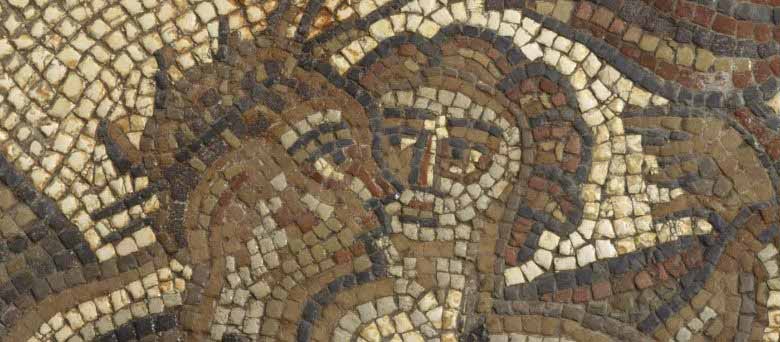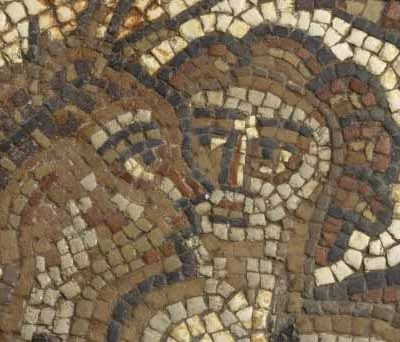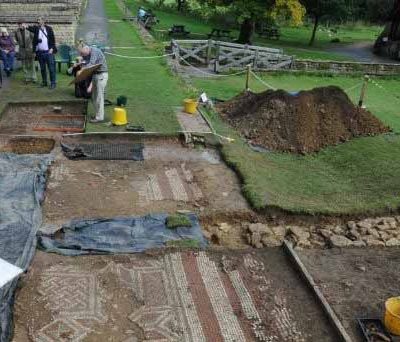
‘Chedworth Roman Villa is one of the best in the country’; a bold statement from Dr Martin Papworth, Archaeologist for the National Trust, at the start of his presentation to BAAS concerning the latest discoveries at the site. And clearly one that is shared by the Heritage Lottery Fund (HLF) who have funded a new cover building and a series of excavations over the past five years. What was apparent was Dr Papworth’s enthusiasm for the complex, which radiated throughout his talk making it an enjoyable and informative experience for BAAS members.
Comparable to Bignor Villa in Sussex, Chedworth Roman Villa was built in c.120 AD in a sheltered valley overlooking the River Coln in Gloucestershire. It is one of several villas known within an 8km radius, just to the north of Corinium Dobunnorum (Cirencester) and near the Fosse Way, suggesting that it was a busy and wealthy area at the time. The site of the Villa appears to have been chosen for its proximity to a natural spring around which an apsidal shrine was built.
The Villa consists of approximately five phases, all of which were examined in great detail by Dr Papworth who proceeded to describe the landscape and creatively portray the lives of the inhabitants, successfully bringing the site to life. In the 2nd century the Villa consisted of three buildings, orientated in the western and the southern parts of the site with a detached bath house to the north. Following a fire in the early 3rd century the south and west wings were rebuilt and the bath house had been enlarged towards the east. However, it was not until the early 4th century that the complex was converted into grand dwelling by connecting the structures with a covered portico around a central courtyard. The bath house was also rebuilt at this time and at least eleven rooms contained fine mosaics. Towards the end of the century, in the 4th Phase, the north wing was extended. Finally in the 5th century the Villa declined in importance and the formal residence reverted back to a farmstead.
The story of the Villa’s discovery was an interesting one and an excellent prelude to Dr Papworth’s description of the recent excavations. Sherds of pottery were found by a gamekeeper during a ferreting exercise in an area of woodland in the 1860s. Funded by the landowner the Earl of Eldon, the wood was felled and an excavation lasting approximately two years was undertaken by James Farrer, who unfortunately left little documentary evidence of the investigation. It was not until the 1880s that a plan of the site was produced by George Fox and the archaeological remains were left open for display beneath three new cover buildings. A custodian was also installed at the newly built Lodge. In 1924 the Villa was sold to the National Trust.
In 2010 and 2011 the HLF, among other local funders, provided the necessary resources to replace the original cover buildings. As with all proposed developments on historic sites, this was subject to a programme of archaeological mitigation which resulted in a series of archaeological evaluations. Dr Papworth provided a detailed explanation of the deposits and features that were uncovered and the new discoveries that are still shedding light on the previous excavations. The most notable features were the 32m long corridor, the mosaics, evidence of several phases of room adaptations and heating flues within the walls. New light was also shed on the latter stages of the Villa, which was previously unknown; post holes were placed through the mosaics in the late Roman period to prop up the building and the mosaics had been patched in the mid-5th century, when it was previously assumed that the Villa had been demolished.
Following the construction of the new cover building, a five year research programme was initiated in 2013 to continue the HLF legacy. The intention of the programme was to excavate the North Range and publish the results from all the previous and current excavations. So far the research has uncovered previously unseen plans of Ian Richmond’s excavations in the 1950s/60s, which has become an ideal basis for the recent excavations and overall interpretation of the site. As requested by Historic England, the excavations principally focused on the exploration of the corridor and mosaics in the North Range. This found that the corridor had been widened and the newly discovered intricate mosaics had been extended. Painted plaster, presumably from the site, had been used as ballast and what in the 1960s was interpreted as several rooms was actually found to be a large reception room (18m in length) that had been divided up by concrete interpretation walls. Evidence of the fire in the early 3rd century was also apparent on the 2nd century walls. A star find was a fragment of imported Greek marble which is extremely unusual and highlights the wealth and trade in the area at the time. Unfortunately very little artefactual data associated with the 3rd century was found but this was alleviated by the discovery of some Iron Age Pottery on the Site.
In the wider landscape, a geophysical survey found the main access route to the Villa running through the base of the valley. It passed a barrow shaped earthen mound that is thought to have had a surrounding circular wall and an adjacent rectangular enclosure, inspiring interpretations of a temple. There is clearly a wealth of information still yet to be explored in the landscape that will provide an essential context for the Villa.
Although last year’s excavations were limited due to wet weather, the team directed by Dr Martin Papworth and Nancy Grave, and advised by Professor Simon Esmonde-Cleary and Professor Peter Salway are keen to return again this August to fulfil their objectives. For more information about the Villa please visit: www.nationaltrust.org.uk/chedworth


Copyright National Trust
